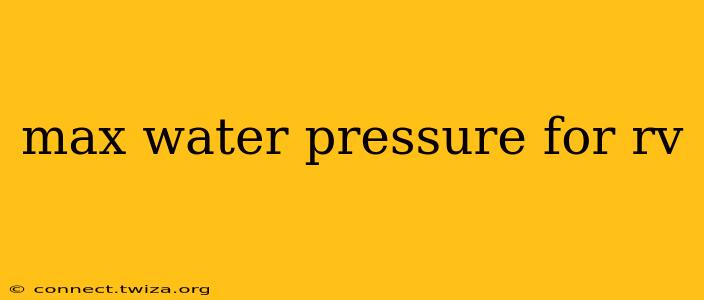RVs offer the freedom of the open road, but maintaining their systems requires attention to detail. One critical aspect is understanding the maximum water pressure your RV can handle. Exceeding this limit can lead to costly repairs, so knowing the safe pressure range is crucial for preserving your investment. This guide delves into the ideal water pressure for RVs, potential issues with high pressure, and how to protect your system.
What is the Maximum Water Pressure for an RV?
The maximum recommended water pressure for most RVs is 50 PSI (pounds per square inch). However, it's important to note that this is a general guideline. Some RVs might tolerate slightly higher pressure, while others may have lower tolerances. Always check your RV's owner's manual for the manufacturer's specified maximum water pressure. This information is vital and should be considered the ultimate authority for your specific model. Ignoring this recommendation could void your warranty and lead to significant damage.
What Happens if the Water Pressure Exceeds the Limit?
Exceeding the maximum water pressure can result in several problems, ranging from minor inconveniences to major repairs:
- Leaking Pipes and Fittings: The most common issue is leaks. High pressure can weaken pipes and fittings over time, eventually leading to leaks, especially at joints and connections.
- Burst Pipes: In extreme cases, high water pressure can cause pipes to burst, resulting in significant water damage and potentially costly repairs.
- Damage to Water Heater: Your RV's water heater is particularly vulnerable to high pressure. Exceeding the safe limit can damage the tank, causing leaks or even a complete failure.
- Failure of Water Pump: The water pump itself can be damaged by excessive pressure, requiring expensive replacement.
- Damage to Faucets and Fixtures: High pressure can also strain faucets, showerheads, and other fixtures, leading to premature wear and tear or breakage.
How to Protect Your RV's Water System from High Pressure
Several strategies can help you protect your RV's plumbing from damage caused by high water pressure:
- Use a Water Pressure Regulator: This is the most effective way to protect your RV's water system. A pressure regulator is an inexpensive device that reduces incoming water pressure to a safe level, typically around 40-50 PSI. It's an essential investment for any RVer.
- Check Your Water Source: Be aware of the water pressure at your campsite or RV park. Some sources provide higher pressure than others.
- Regularly Inspect Your Plumbing: Periodically check your RV's plumbing system for leaks, loose fittings, and other signs of wear and tear. Early detection can prevent more serious damage.
- Know Your RV's Limits: Always refer to your RV's owner's manual for specific recommendations regarding water pressure.
- Use a Water Filter: While not directly related to pressure, a water filter can help remove sediment and other contaminants that can clog pipes and fixtures.
How to Find Your RV's Water Pressure?
You can typically check the water pressure using a pressure gauge installed on your water hookup or by using a portable pressure gauge attached to your water line. Many RV parks also provide water pressure information.
What is the best water pressure for an RV?
While the maximum is 50 PSI, aiming for a slightly lower pressure, around 40-45 PSI, is often recommended. This provides adequate water flow while offering extra margin of safety.
Can I use a pressure washer on my RV?
No. Pressure washers operate at significantly higher pressures than your RV plumbing can handle and are not appropriate for cleaning the exterior of an RV.
By taking these precautions and understanding the maximum water pressure for your RV, you can help ensure the longevity and reliability of your plumbing system and enjoy worry-free adventures on the road. Remember that consulting your RV's manual remains the best resource for specific advice regarding your model.
